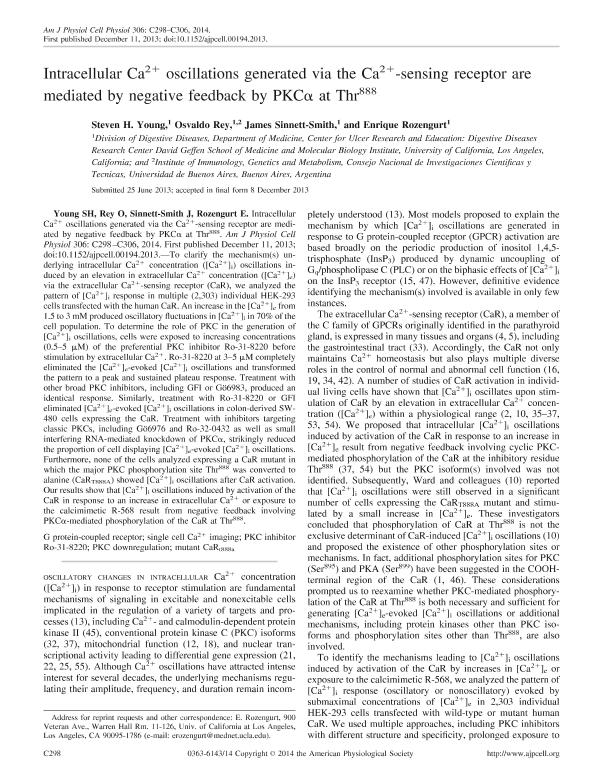Mostrar el registro sencillo del ítem
dc.contributor.author
Young, Steven H.
dc.contributor.author
Rey, Osvaldo

dc.contributor.author
Sinnett Smith, James
dc.contributor.author
Rozengurt, Enrique
dc.date.available
2017-06-22T16:30:01Z
dc.date.issued
2014-03
dc.identifier.citation
Young, Steven H.; Rey, Osvaldo; Sinnett Smith, James; Rozengurt, Enrique; Intracellular Ca2+ oscillations generated via the Ca2+-sensing receptor are mediated by negative feedback by PKCα at Thr888; American Physiological Society; American Journal of Physiology-cell Physiology; 306; 3; 3-2014; 298-306
dc.identifier.issn
0363-6143
dc.identifier.uri
http://hdl.handle.net/11336/18639
dc.description.abstract
To clarify the mechanism(s) underlying intracellular Ca2+ concentration ([Ca2+]i) oscillations induced by an elevation in extracellular Ca2+ concentration ([Ca2+]e) via the extracellular Ca2+-sensing receptor (CaR), we analyzed the pattern of [Ca2+]i response in multiple (2,303) individual HEK-293 cells transfected with the human CaR. An increase in the [Ca2+]e from 1.5 to 3 mM produced oscillatory fluctuations in [Ca2+]i in 70% of the cell population. To determine the role of PKC in the generation of [Ca2+]i oscillations, cells were exposed to increasing concentrations (0.5–5 μM) of the preferential PKC inhibitor Ro-31-8220 before stimulation by extracellular Ca2+. Ro-31-8220 at 3–5 μM completely eliminated the [Ca2+]e-evoked [Ca2+]i oscillations and transformed the pattern to a peak and sustained plateau response. Treatment with other broad PKC inhibitors, including GFI or Gö6983, produced an identical response. Similarly, treatment with Ro-31-8220 or GFI eliminated [Ca2+]e-evoked [Ca2+]i oscillations in colon-derived SW-480 cells expressing the CaR. Treatment with inhibitors targeting classic PKCs, including Gö6976 and Ro-32-0432 as well as small interfering RNA-mediated knockdown of PKCα, strikingly reduced the proportion of cell displaying [Ca2+]e-evoked [Ca2+]i oscillations. Furthermore, none of the cells analyzed expressing a CaR mutant in which the major PKC phosphorylation site Thr888 was converted to alanine (CaRT888A) showed [Ca2+]i oscillations after CaR activation. Our results show that [Ca2+]i oscillations induced by activation of the CaR in response to an increase in extracellular Ca2+ or exposure to the calcimimetic R-568 result from negative feedback involving PKCα-mediated phosphorylation of the CaR at Thr888.
dc.format
application/pdf
dc.language.iso
eng
dc.publisher
American Physiological Society

dc.rights
info:eu-repo/semantics/openAccess
dc.rights.uri
https://creativecommons.org/licenses/by-nc-sa/2.5/ar/
dc.subject
Casr
dc.subject
Gpcr
dc.subject
Proliferation
dc.subject
Signal Transduction
dc.subject.classification
Bioquímica y Biología Molecular

dc.subject.classification
Ciencias Biológicas

dc.subject.classification
CIENCIAS NATURALES Y EXACTAS

dc.title
Intracellular Ca2+ oscillations generated via the Ca2+-sensing receptor are mediated by negative feedback by PKCα at Thr888
dc.type
info:eu-repo/semantics/article
dc.type
info:ar-repo/semantics/artículo
dc.type
info:eu-repo/semantics/publishedVersion
dc.date.updated
2017-06-21T17:38:43Z
dc.identifier.eissn
1522-1563
dc.journal.volume
306
dc.journal.number
3
dc.journal.pagination
298-306
dc.journal.pais
Estados Unidos

dc.journal.ciudad
Bethesda
dc.description.fil
Fil: Young, Steven H.. University of California at Los Angeles; Estados Unidos
dc.description.fil
Fil: Rey, Osvaldo. University of California at Los Angeles; Estados Unidos. Consejo Nacional de Investigaciones Científicas y Técnicas. Oficina de Coordinación Administrativa Houssay. Instituto de Inmunología, Genética y Metabolismo. Universidad de Buenos Aires. Facultad de Medicina. Instituto de Inmunología, Genética y Metabolismo; Argentina
dc.description.fil
Fil: Sinnett Smith, James. University of California at Los Angeles; Estados Unidos
dc.description.fil
Fil: Rozengurt, Enrique. University of California at Los Angeles; Estados Unidos
dc.journal.title
American Journal of Physiology-cell Physiology

dc.relation.alternativeid
info:eu-repo/semantics/altIdentifier/url/http://ajpcell.physiology.org/content/306/3/C298.long
dc.relation.alternativeid
info:eu-repo/semantics/altIdentifier/doi/http://dx.doi.org/10.1152/ajpcell.00194.2013
Archivos asociados
